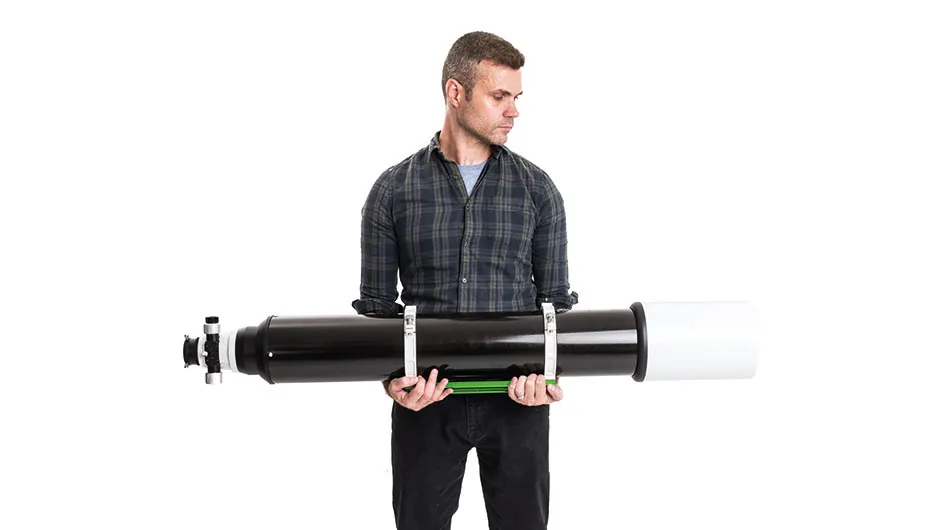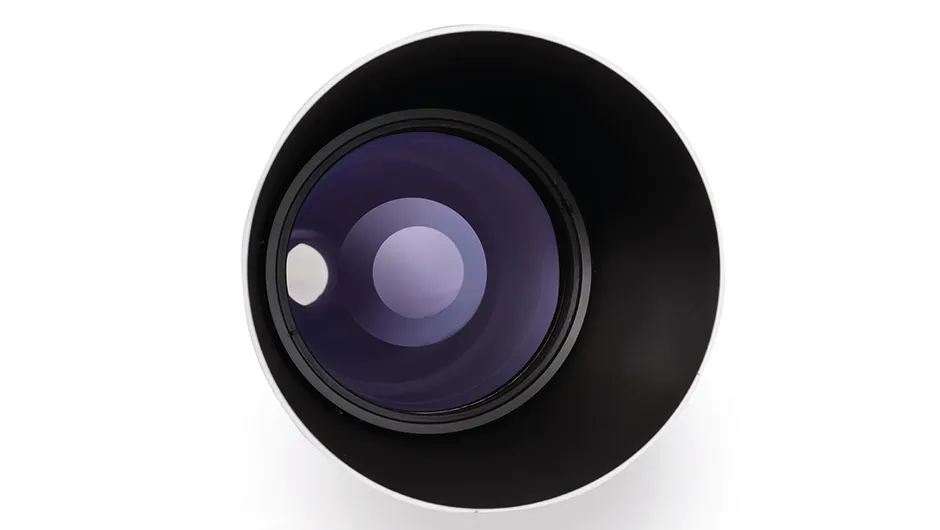Anticipation and excitement have surrounded the launch of Sky-Watcher’s Evostar 150ED DS-Pro, a new, 6-inch, f/8 refractor.Competitive pricing has also caught the astronomy community’s attention, especially among those familiar with the impressive quality of the optics in the smaller, 120ED Evostar.
As this new scope has the potential to be an excellent all-rounder, we decided to test it across a number of tasks: planetary and lunar viewing; double stars; deep-sky observation; and photographic performance.
The first thing that strikes you is the size of the thing, but thanks to the aluminium tube it’s surprisingly lightweight and easy to handle.
To help with the balance we fitted our 50mm finderscope to the shoe provided, and – after some speedy basic collimation – we decided to use the new Moon period to first try some astrophotography, using an optional 0.85x focal reducer on loan for the review.
DSLR cameras fit directly onto the focal reducer with the supplied Canon T-ring.
When we tested this configuration out on a star field, the result was a very impressive flat field, with good, round stars right into the corners of our full-frame DSLR, and only minor vignetting.
Targeting the Dumbbell Nebula, M27, just 40 minutes’ worth of 45 second exposures revealed quite reasonable details and, importantly, no annoying colour rings on bright stars.

We went on to photograph NGC 7789, Caroline’s Rose, and NGC 6992, the Eastern Veil Nebula, again with pleasing results.
Swapping to our monochrome CCD camera meant we could no longer use the reducer, and without it the star shapes elongated a little in the corners of our small ICX694 camera sensor.
On the plus side, the CCD allowed us to test the colour correction of the doublet lens in the 150ED.
After finding the point of sharpest focus through a luminance filter, we used parfocal filters to take pictures through red, green, blue and narrowband filters.The results were very good; close to the best that can be expected from a doublet lens.
Excited by the scope’s performance so far, we were keen for some time at the eyepiece, but patiently used two nights of limited summer skies for some narrowband imagining.
Just four hours total exposure was enough to reveal the very faint outer gases of the Dumbbell Nebula under average skies.
Observing the planets
With four major planets on offer, we could no longer resist a visual session, and fitted our 2-inch diagonal.Under twilight conditions Venus showed its phase well, our 4.5mm eyepiece giving a just-about acceptable 266x magnification.
At best focus we could barely detect any false colour on the bright edge, just the standard red blue effects of atmospheric refraction.
As it darkened we moved to Jupiter and were admittedly a little disappointed at the initial view.It seemed to lack contrast and surface definition, even at 120x.
During the season in question, Jupiter was very low, and softer views might be expected, so giving the scope the benefit of the doubt we decided to do a star test instead.
Our green filter and 4.5mm lens gave a round star with concentric diffraction rings, but 1mm of defocus either way gave a sharper pattern.
Returning to Jupiter on subsequent nights gave similar, slightly soft results but planetary viewing conditions were far from ideal.In comparison to our own Sky-Watcher 150ED Esprit, the Evostar demonstrated less contrast and definition in the equatorial bands.
On double stars the 150ED was a delight.It revealed very clean, wide splits for both Epsilon (ε) and Iota (ι) Cassiopeia.
At 533x we even managed to bag the very close double Zeta (ζ) Herculi, which is extra tricky as the small companion resides in the first diffraction ring.
With six inches of clear aperture, optimised colour correction, impressive photographic performance and an attractive price, the 150ED DS-Pro may well set a new benchmark for must-have telescopes.

Outstanding feature:6-inch doublet lens
Aperture is king, they say, and at six inches in diameter the Evostar 150ED DS-Pro likely presents the maximum manageable size of refractor for many amateurs.
The doublet lens is multi-coated and displays a purplish hue.
Photographic tests showed no sign of unwanted reflections or artefacts, and visual star tests demonstrate that the lens cell holds the glass without evidence of skewing or pinching, even through temperature drops of over 10°C.
The large aperture makes finding fainter objects easier, and even with moonlit skies and moderate light pollution we could observe both major sections of the Veil Nebula complex with our OIII filter and 21mm eyepiece.
Meanwhile, planetary nebulae such as M57 and M27 stood out really well from the background sky.
Globular and open clusters were sharp and clear, and bright star Vega showed only the faintest trace of false colour as the seeing varied.
Lunar views during steady seeing showed good detail in crater walls and we easily picked out the main craterlets within the crater Plato.
Sky-Watcher Evostar 150ED DS-Pro refractor: outstanding features
Tube rings
Dedicated tube rings mounted on a green Vixen-style dovetail provide a stable platform and, feature a ¼-20 thread bolt and clamping ring for accessories.Upgraded CNC-machined rings are available on a wider, Losmandy dovetail, appealing to those using the 150ED for astrophotography.
Storage case
Safely storing and transporting the Evostar 150ED is made easier thanks to the large aluminium case it comes in. Measuring 140x39x29cm, the locking, padded case contains helpful cut-outs for accessories and eyepieces, and has handles at either end to make carrying it easier.The combined weight is around 24kg.
Size and balance
Handling and mounting long telescope tubes can sometimes be tricky and heavy accessories at one end can exert a lot of leverage on a mount.With the end cap removed, and a finderscope and star diagonal with medium eyepiece in place the balance point is roughly at the halfway point of the tube.
Focuser
A simple, non-rotating, dual-speed Crayford focuser is fitted.Focusing is a smooth process, but our test version slipped when used with a heavy camera or eyepiece and required adjustment.The locking screw had the annoying habit of shifting focus slightly when locked, which made astrophotography in particular more difficult.
Dewshield and tube
The lightweight tube features a collimatable lens cell and a fixed, large dewshield with 200mm of dew and stray light control.Within the matte black tube are graduated baffles, which help reduce unwanted incidental light and improve contrast, while the outside has an attractive metallic black finish.
Vital stats
- Price £1699.00
- Aperture 6-inch (150mm)
- FocalLength 1,200 (f/8)
- Weight 9.5k
- Supplier Optical Vision Ltd
- Websitewww.opticalvision.co.uk
This review originally appeared in the October 2018 issue of BBC Sky at Night Magazine
